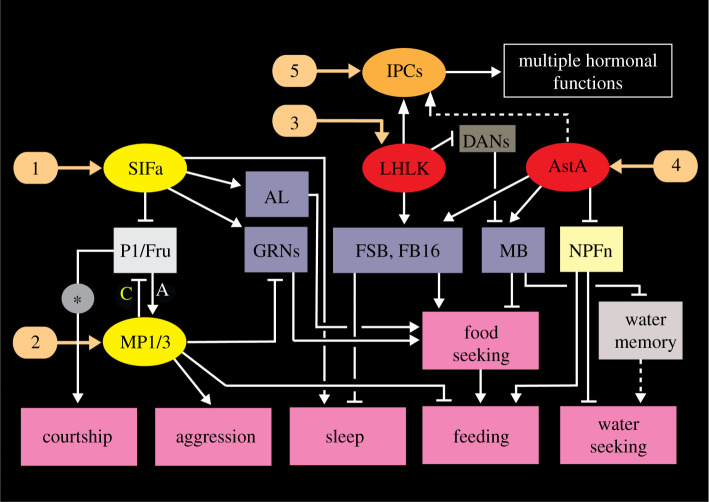Figure 10.
Summary diagram of peptide signalling that regulates competing behaviours. SIFamide (SIFa) and drosulfakinin (DSK)-expressing (MP1/3) neurons interact with several brain circuits to regulate behaviours in an orchestrating fashion, some of which are competing. One hub that regulates courtship versus aggression under peptidergic influence is a set of FruM-expressing P1 neurons. The asterisk indicates additional neuronal circuitry (see electronic supplementary material, figure S3). SIFa and DSK also target antennal lobe (AL) neurons and gustatory receptor neurons (GRNs) to regulate food search and feeding. LHLKs are leucokinin-expressing neurons that target different circuits in the fan-shaped body (FSB in general, or layer 16, FBl6, specifically) or mushroom bodies (MB) via dopaminergic neurons (DANs) to regulate sleep and food choice. LHLKs also regulate insulin-producing cells (IPCs) to affect sleep/metabolism interactions. Allatostatin-A neurons (AstA) target FSB and MB to regulate food choice and sleep, and neuropeptide F-expressing neurons (NPFn) to modulate feeding and water seeking. The IPCs release insulin-like peptides (DILPs) to regulate feeding, metabolism, sleep and other functions. The numbers (1–5) indicate inputs to the different neurons systems as follows, 1 (SIFa): myoinhibitory peptide, hugin-PK, clock inputs, and probably corazonin (CRZ), DILPs, DSK and short neuropeptide F (sNPF); 2 (MP1/MP3): nutritional state, P1 neurons, age, housing conditions; 3 (LHLK): nutritional state, thirst, clock; 4 (AstA): dopamine, pigment-dispersing factor, nutritional state; 5 (IPCs) nutritional state, clock, GABA, serotonin, octopamine, dopamine, DILPs, allatostatin-C (AstC), neuropeptide F (NPF), short NPF (sNPF), CCHamide2, tachykinin (TK), adipokinetic hormone (AKH), and CRZ. For references, see text.

